Homemade orange zest powder
A pleasant, intensive scent and bright color of orange peel makes it very attractive for use in culinary art and cosmetics. Orange peel is frequently used to make tea, sweets, air fresheners and potpourris. Orange zest (the outer colored layer of orange peel) is the source of fragrant orange essential oil that is often used as a flavoring agent for sauces, desserts, chocolate and liqueurs. Powdered orange zest and its extract are often included in various cosmetic and bath products. In handmade cosmetics they can be used for formulations of face cleansers, face masks, scrubs, dry shampoos and bath products. They can also be used as a natural colorant in handmade soaps.
Besides the essential oil (with D-limonene as its major constituent), orange zest contains sugars, calcium, potassium, citric acid, vitamin C, flavonoids and many other compounds.
How to make an orange zest powder
Orange zest powder obtained in the way described here has a beautiful orange color and a strong orange scent. Proper drying of orange zest is a key step to obtaining good results. Orange zest must be dried quickly at low temperature to prevent evaporation of the highly volatile orange essential oil (EO).
Thorough drying is important since moisture allows mold growth making this powder unusable. Properly dried zest powder stored in an airtight glass container at a dark, dry and cold place can last for several months. With time, its quality decreases due to evaporation of the essential oil, so it is best used freshly prepared whenever possible.
Depending on the orange size and the thickness of the peeled zest, one orange yields about 4-5g (.14 - .18 oz) of zest powder.
To make orange zest powder, use only organically grown oranges with healthy skin. Gently wash the oranges with an abrasive sponge and soapy water to remove all the dirt from the surface, and then wipe them to dry.
Peel off only the thin, colored layer (the surface layer of peel called zest or flavedo). Avoid the white layer (inner, spongy layer called pith or albedo) because it does not contain any essential oil.
Peel the zest in pieces of similar thickness, which will allow them to dry simultaneously. Place the zest pieces on wax paper in a thin layer and let them dry in the oven for 1-2 hours at 35°C (95°F). If your oven has a fan, turn it on. Air circulation is very helpful when drying at low temperatures. Leave the oven door slightly open to allow moist air to escape.
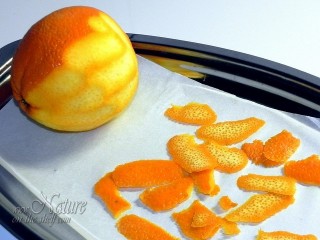
It is important to keep the drying temperature between 35°C and 40°C (95-104°F) in order to minimize essential oil loss. As it is highly volatile, it will evaporate anyway (the whole house will smell after oranges), but if exposed to higher temperatures, it will be almost entirely lost. The use of an oven-fan will significantly shorten the drying time i.e. the exposure of EO to the heat.
Optional: In case of hot weather outdoors, you can dry the zest in the open air. Spread it in a thin layer at a well-aerated area protected from direct sunlight. Depending on humidity, it will take two or three days, or even more, to dry the zest in this way.
The orange zest is dry when it crushes under pressure. Once it is dry, turn the oven off to prevent further loss of EO. Let it cool and grind it in a coffee grinder or in a food processor.
Dried orange zest is rock-hard and its grinding takes a little more time, which implies that it can be ground to fine powder. The zest powder obtained by using a coffee grinder is a mixture of coarse and fine particles, and as such it can be used for making exfoliating scrubs. During grinding, a portion of the powder will stick to the grinder walls because the zest contains EO which is oily, of course, and tends to stick. This powder portion is valuable, so it should be collected carefully.
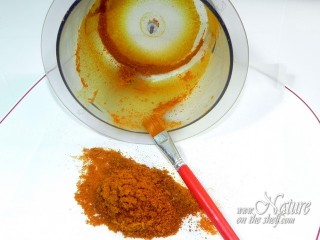
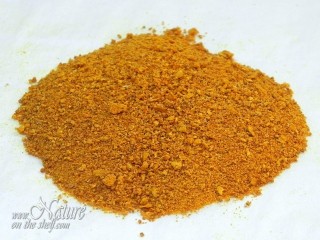
Obtaining of fine powder requires sifting through a series of sieves of different sizes and further grinding by hand in a mortar.
Properly dried ground zest will crush to powder under pressure by using a pestle and a mortar. If grinding in a mortar results with clumps instead of powder, it means that the zest still contains moisture. In that case you should dry it in the oven for another 15 minutes at 35°C (95°F). Do not use the oven-fan during this step. Place the powder on the wax paper in a thin layer and put it on the oven grid. Do not use the oven tray because it will overheat and burn your powder and all EO will evaporate. Ground orange zest is much more sensitive to EO loss than the whole zest because the glands holding EO in the zest are broken now and EO evaporates easily. Leave the dried powder to cool before further processing.
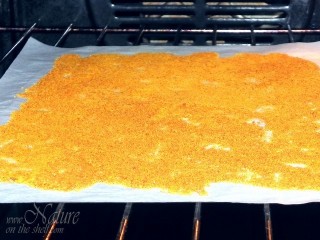
Sift the ground powder through a sieve to separate coarse particles and grind them using a pestle and a mortar. Mix these two powders together and sift them through a denser sieve. Repeat the procedure of grinding in a mortar and sift again.
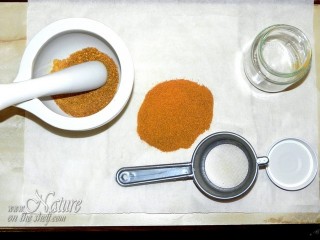
For final sifting, pour the powder into a small jar and stretch two layers of nylon stockings over the jar’s mouth. Fix them with a rubber band. Sift the finest powder out of the jar as if you would use a saltshaker. The last sifting requires patience because fine powder particles clog nylon openings, so it is necessary to keep tapping the jar gently in order to release the powder particles trapped between nylon threads. It takes about 15-20 minutes to sift 20g ( .7oz) of powder.
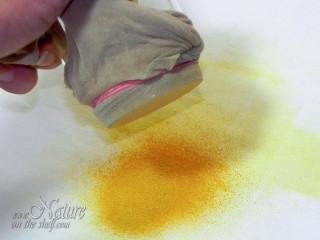
This method of powder sifting yields quite a fine powder fraction. You can use it in making handmade cosmetics when non-abrasive powder is desired. The coarse fraction which remains in the jar can be used as a natural exfoliant in homemade cosmetics or it can be further ground in a mortar and sifted again.
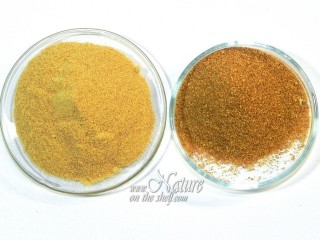
It is very important to use only organically grown oranges that are free of any pesticides. Orange peel contains a high amount of natural oils and waxes which are excellent solvents for pesticides. All the chemicals used for spraying the oranges concentrate in the outer layer of the peel i.e. in its zest. The chemicals are concentrated within the orange zest tissue and it is not possible to remove them by washing of the orange surface. If the peel of sprayed oranges is used, after dehydrating of the peel you will obtain a highly concentrated mixture of pesticide metabolites in your product. They can cause chronic health consequences if such a product is regularly applied to the skin, which is the case if you use zest powder for making cosmetic products.
How to use orange zest powder in handmade cosmetics
In cosmetics, orange zest powder is used in skin care and hair care preparations. It can be included in dry, oily or water-based formulations.
Orange zest powder prepared by grinding of dried orange zest contains hard particles of plant tissue, which makes this powder insoluble in water and oils. Those particles may be scratchy. The powder can be incorporated in cosmetic formulations directly, as a powder, when the scratchy feeling does not affect the desired qualities of the formulation. For some recipes, the powder needs to be dispersed in water or oil before mixing with other ingredients.
In the preparation of products with smooth texture where any scratchy effect is not acceptable (like skin cleansers, creams or lotions), active ingredients from orange zest powder need to be extracted in a liquid solvent like oil or water and then filtered to remove hard powder particles. Extraction can be made by infusion in water or herbal distillate (hydrosol) or by maceration in oil or water. When making these types of extract, the usual ratio is 10% of orange zest powder and 90% of solvent.
The dosage of orange zest powder in cosmetic recipes is usually 2-3% in leave-on products (facial creams, lotions and similar products) up to 40-50% or more in body scrubs.
Cosmetic effects of orange zest
Orange zest powder, as well as products based on it, is usually recommended for oily and normal skin. Its active ingredients gently remove dead skin cells and stimulate blood circulation. Consequently, cosmetics based on orange zest unclog pores and cleanse the skin, making it radiant. Along with its anti-inflammatory action, this makes it suitable for the treatment of acne, pimples, blackheads and scars. In formulations intended for acne treatment, the powder should be macerated and filtered to remove hard particles. Orange zest is rich in antioxidants and hence it can be used for prevention of wrinkles and in anti-aging preparations.
In hair care, orange zest brings softness, shine, strength and flexibility to the hair. It is recommended for all hair types. Orange zest powder can be incorporated in dry shampoos or hair masks. It also can be infused or macerated in water and then used in the preparation of hair tonics, liquid shampoos, hair masks or conditioners.
* Be careful when you use it and do not overdose in the formulation since D-Limonene, a major constituent of citrus essential oils, can cause skin irritation. Test it first on a small patch of your skin. If you have sensitive skin, use this ingredient under the supervision of your dermatologist.
